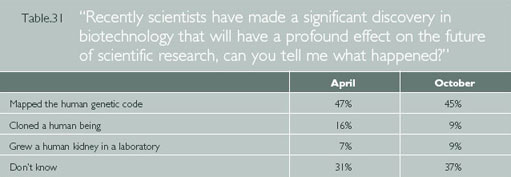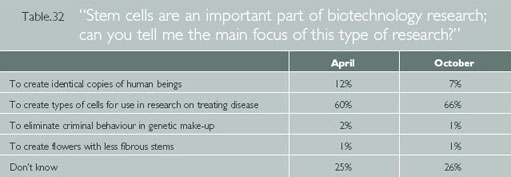10.9 The media and public understanding of cloning and genetic medical research
Hargreaves, I., Lewis, J. and Speers, T. ‘Towards a better map: Science, the public and the media’, Economic and Social Research Council.
The topic of cloning and genetic medical research has received a great deal of research in terms of the public understanding of science. The Wellcome Trust, in particular, (an independent research-funding charity that aims to improve human and animal health) has played a key role in researching public attitudes towards cloning.
Like many such studies, we found a high degree of public uncertainty. Of the three issues under scrutiny in our study, this would appear to the one most people find esoteric. While most people claimed to be ‘well’ or ‘partly’ informed about climate change and MMR, more than two thirds in our October survey (68 per cent) admitted to feeling not very well informed about this area of scientific research.
This may well be partly a response to the way the fact that this remains very much a ‘science’ story. Our media analysis suggested that the cloning/genetic medical research story is the most likely of the three to involve scientists as sources and the least likely to provoke engagement in newspaper editorials or letters pages.
Interestingly however, when asked questions about the scientific aspects of the story our respondents did not do conspicuously worse in this area than the other two. What does stand out, in terms of our knowledge index, is the consistently high number of ‘don't knows’, in response to questions on this issue. In our October survey, for example, the percentage of ‘don't knows’ in response to questions on this issue never dropped below 26 per cent (while three questions on the other two issues produced ‘don't knows’ of five percent or less). In short, if people are more confident than they should be about their knowledge of climate change and MMR, they are much more tentative about cloning and genetic medical research.
So, for example, close to half our respondents were aware that one the key developments in biotechnology in recent years has been the mapping of the human genetic code.
And most people are aware that the main aim of stem cell research is to create cells to research the treatment of disease.
Both the questions also indicate a small but interesting shift, between April and October, away from the association with the more stereotypical images of cloning. Thus the percentage assuming that the key development in biotechnology was to have ‘cloned a human being’ dropped from 16 per cent to nine per cent, while those assuming the main focus of stem cell research was to ‘create identical copies of human beings’ dropped from 11.5 per cent to 6.5 per cent. By contrast, those associating stem cell research with the treatment of disease increased from 60 per cent to 66 per cent.
This suggests that some progress may have been made since the Wellcome Trust's 1998 report Public Perspectives on Human Cloning, which used focus groups and in-depth interviews to see how attitudes were ‘influenced by the provision of extra information’. They found that the public's acceptance of research on cloned embryos was ‘dependent on there being direct medical benefits’ – something our study suggests there is now an awareness of.
Overall, our analysis of media coverage found the presence of both the ‘concern’ and ‘great promise’ frameworks in the coverage (Kitzinger and Reilly, 1997). It is possible that while they do not appear to be capturing the public imagination, the sheer repetition of ‘great promise’ stories is beginning to seep through, thereby strengthening the association between cloning and genetic medical research and the treatment of disease.
The presence of the ‘concern’ framework, on the other hand, is most clearly revealed in relation to questions of public policy, in which public ignorance is widespread. The House of Lords decision to permit experimentation on cloned embryos in late February was covered by all the major media, and yet most people were not only unaware of this, they assumed that such things were not legal in Britain. In both surveys we asked whether the government allowed UK scientists to ‘clone human embryos’, and only around a quarter said yes (28 per cent in April, dropping to 22 per cent in October), while around twice as many (46 per cent and 48 per cent) said no.
Thus not only are most people unaware of public policy in this area, the presence of the ‘concern’ framework is still palpable enough for many people to assume the government could not have sanctioned this kind of research. Indeed, in this case, recourse to the ‘concern’ framework appears to have increased slightly between April and October.
We were aware that the phrase ‘clone human embryos’ is particularly powerful in triggering the concern framework, so in October, we also asked essentially the same question using different, less obviously evocative phrasing (removing the words ‘clone’ and ‘embryo’ and substituting it with phrase ‘make exact copies of human cells’). While this did appear to reduce the assumptions of the concern framework somewhat (by around six per cent), the overall direction of responses remains the same.8
Thus it appears that while the ‘great promise’ framework informs an understanding of where the science is moving, the ‘concern’ framework comes to the fore in discussions of public policy. This suggests that many people have some way to go in connecting the realms of science and policy, the former being seen as generally positive, the latter being burdened by images of cloned human beings (a development most people clearly oppose).
Policymakers in the public understanding of science movement often argue that the more science the public knows, the more supportive they will be on this issue (a point debated in some of the academic literature). Either way, it seems likely that since most people have such little confidence about their knowledge in this area, attitudes are clearly far from entrenched. They appear to depend on whether people are thinking with the ‘concern’ framework in mind, or whether the ‘great promise’ framework is more to the fore. To test this, both surveys contained two questions to gauge people's attitudes towards genetic science. In April, these were asked first; whereas in October, they were both deliberately placed immediately after the question in which a majority had stated that the main aim of stem cell research was the treatment of disease.
What we found was that a fairly small change in question order produced a significant shift in response away from the concern framework towards the great promise notion. In the first survey, when asked out of the blue, ten per cent more people found these trends worrying than encouraging. In the second survey (two thirds having just answered a question linking genetic research to the treatment of disease), the change in context appears to reverse the response, with ‘encouraging’ outscoring ‘worrying’ by nine per cent.
Similarly, the number of people concerned about the regulation this research drops by 12 per cent in the second survey, from 50 per cent to 38 per cent.9
In both cases, it appears that the more knowledge people have of the overall drift of this research, the more encouraged they are by developments in this area. This is confirmed when we break down responses to these questions. In the April survey, for example, when most people were more worried than encouraged, those with any science education were 19 per cent more likely to find the research ‘encouraging’ rather than worrying. (54 per cent versus 35 per cent).
This does not mean that the media or the public have no cause for concern: the ethical boundaries of such research are clearly important matters for public discussion. What matters here is that the concerns people have are based on a broad understanding of the risks and potential of medical science. And despite people's lack of confidence about their knowledge of this issue, our survey suggests that the coverage has reported the medical benefits of such research and that this coverage shows signs of forming part of the public understanding.
The challenge, for scientists, policy makers and journalists, is to move away from the dichotomies of the great promise and concern frameworks towards a more integrated approach, whereby we can decide what kind of scientific research we should support and which we should not. To this end, we would make the following suggestions:
-
Scientists, policy makers and journalists should find ways of engaging the public more in this story without resorting to ‘wacky science’ stories about things such as the cloning of prehistoric creatures. Some television and newspaper articles, for example, have attempted to inject stories about the medical science with human interest.
-
At the same time, there is still much to be done before people feel confident about this issue. While media – including the tabloids – have attempted to explain the science (and to connect the dots between words like ‘stem cells’ and ‘cloning’), these points will bear a great deal of repetition if the public are able to construct a coherent set of associations with which to make sense of it all.
8 Ignorance of policy in this area was also reflected in a question about the ownership of genetic information, only a quarter of respondents being aware that such information is in both the public and private domain.
9 Needless to say, in both surveys most people are clearly unaware of what the Government is or is not doing, and their answers must be seen in that context.







